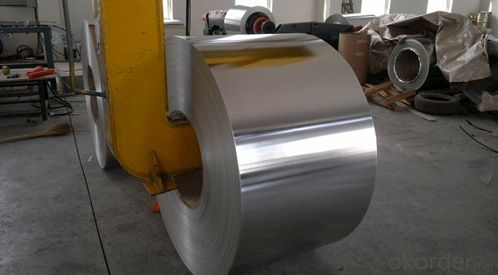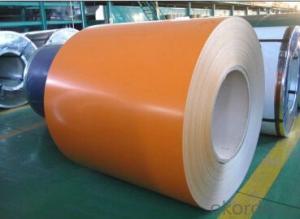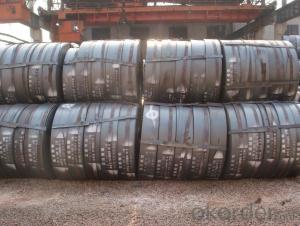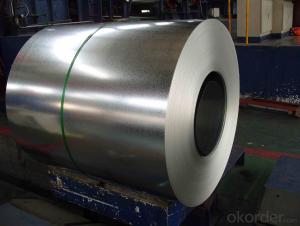Hod Dip Full Hard Galvanized Gi Steel Coil
- Loading Port:
- Tianjin
- Payment Terms:
- TT OR LC
- Min Order Qty:
- 50 m.t.
- Supply Capability:
- 3000 m.t./month
OKorder Service Pledge
OKorder Financial Service
You Might Also Like
Specification
Product Brief Introduction
Hot Dip Full Hard Galvanized Gi Steel Coil
--- Hot Dip Full Hard Galvanized Gi Steel Coil applies to construction field, ships building industry, petroleum,
chemical industries, war and electricity industries, food processing and medical industry,
boiler heat exchanger,machinery and hardware fields.
Product Features
. Traditional aesthetics outlook
. Suitable for new house or renovation.
. Long life service
. Tedun also provide relative ridge cap, fasteners and other accessories
Product Specification
Standard:ASTM, GB,JIS,JIS G3302 ASTM 755 EN10169
Grade: DX51D CGCC CS
Thickness: 0.12mm~4.0mm,
Width: 1250,600-1250mm
weight:3-12 MT
Chemical composition:
C | Si | Mn | Cr | Ni | P | S |
0.150 | 0.476 | 11.231 | 12.50 | 0.900 | 0.039 | 0.010
|
FAQ
1. How long will we receive the goods ?
45days after receiving workable L/C
1. how do you control the quality ?
we have our own quality control department ,we will arrange QC person to see the production line ,when goods finish ,before shipment ,our QC person will check the quality as per our test report request ,if the goods is ok ,then we issue the test report ,and we allow the goods shipping ,otherwise will not allow ship the goods.

- Q: What is the creep resistance of a steel strip?
- The creep resistance of a steel strip refers to its ability to resist deformation or creep under sustained or long-term stress at elevated temperatures. Creep is a phenomenon where materials slowly deform over time when subjected to a constant load or stress at high temperatures. This can be particularly critical in applications where the steel strip is exposed to high temperatures for extended periods. The creep resistance of a steel strip is influenced by several factors, including the composition and microstructure of the steel, as well as the temperature and stress levels it is exposed to. Steel strips with a higher content of alloying elements such as chromium, molybdenum, and vanadium tend to exhibit better creep resistance. Additionally, a fine and homogeneous microstructure with a controlled grain size can enhance the creep resistance of the steel strip. Testing methods such as creep tests are used to evaluate the creep resistance of steel strips. These tests involve subjecting the strip to a constant stress or load at a specified temperature for an extended period and measuring the resulting deformation. The creep resistance is then determined by analyzing the deformation characteristics of the material over time. Creep resistance is an important consideration in various industries, including power generation, aerospace, and automotive, where components are exposed to high temperatures and sustained stresses. By choosing a steel strip with high creep resistance, engineers and manufacturers can ensure the longevity and reliability of their products in such demanding environments.
- Q: Can steel strips be used in the production of watch cases?
- Watch cases can indeed be made using steel strips. The durability, strength, and corrosion resistance of steel make it a popular choice for watch cases. Steel strips can be effortlessly molded and shaped to achieve various designs, enabling a wide array of styles and sizes. Moreover, steel watch cases have a timeless and elegant appearance that is greatly sought after by numerous watch enthusiasts. In conclusion, steel strips are a suitable and frequently employed material for crafting watch cases.
- Q: What are the common surface rust prevention methods for steel strips?
- Steel strips can be protected from corrosion through various surface rust prevention methods. These methods are effective in safeguarding the material and include: 1. Paint coating: A layer of paint applied to the steel strips acts as a barrier, preventing moisture and oxygen from reaching the metal. By doing so, the formation of rust is inhibited, and the lifespan of the steel strips is prolonged. 2. Galvanization: This process involves applying a layer of zinc to the surface of the steel strips. Zinc serves as a sacrificial anode, corroding before the steel does. Consequently, even if the zinc layer gets damaged, the steel remains protected from rust. 3. Electroplating: In this technique, a thin layer of chromium or nickel is deposited onto the surface of the steel strips. This layer acts as a protective barrier against rust, augmenting the steel's appearance and durability. 4. Rust inhibitors application: Chemical compounds known as rust inhibitors, rust preventatives, or rust converters can be applied to the steel strips' surface. These inhibitors create a protective film that hinders the formation of rust. 5. VCI (Volatile Corrosion Inhibitors) packaging: VCI packaging involves enclosing the steel strips in a material that emits volatile corrosion inhibitors. These inhibitors generate a protective atmosphere around the steel, effectively preventing rust formation, even in humid conditions. 6. Phosphating: The process of phosphating entails applying a layer of phosphate coating to the steel strips' surface. This coating enhances paint adhesion and acts as a protective barrier against rust. It should be noted that the selection of a rust prevention method depends on factors such as the intended use of the steel strips, environmental conditions, and budget constraints.
- Q: What are the different edge finishes for steel strips?
- Some common edge finishes for steel strips include mill edge, slit edge, deburred edge, rounded edge, and sheared edge.
- Q: Can steel strips be used in the manufacturing of watches?
- Yes, steel strips can be used in the manufacturing of watches. Steel is a durable and commonly used material in watchmaking, and it is often used for watch cases, bracelets, and other components. Steel strips can be shaped, machined, and finished to meet the specific design and functional requirements of a watch, making it a versatile and popular choice in the industry.
- Q: Can steel strips be used for making agricultural machinery?
- Indeed, agricultural machinery can indeed be crafted using steel strips. Given its robustness, longevity, and ability to resist deterioration, steel is a widely employed material in the production of agricultural machinery. Steel strips can be skillfully manipulated, fused, and molded into diverse components utilized in agricultural machinery, including plows, harrows, cultivators, seeders, and planters. Furthermore, for enhanced resistance against corrosion, steel strips can be galvanized, rendering them ideal for deployment in outdoor agricultural settings. On the whole, steel strips possess the essential attributes to endure the arduous conditions and rigorous utilization commonly linked with agricultural machinery.
- Q: What is the surface finish of steel strips?
- The surface finish of steel strips can vary depending on the intended use and manufacturing process. Some common surface finishes for steel strips include: 1. Hot-rolled: This finish is achieved by heating the steel strips above their recrystallization temperature and then rolling them through a series of rollers. It results in a rough, scaled surface. 2. Cold-rolled: This finish is obtained by passing the hot-rolled steel strips through a series of cold reduction mills, which compress and shape the material. Cold-rolling produces a smoother and more refined surface compared to hot-rolling. 3. Pickled and oiled: This finish involves soaking the steel strips in an acidic solution to remove any scale or impurities, followed by applying an oil coating to protect against corrosion. It provides a clean, smooth, and slightly oily surface. 4. Galvanized: This finish involves applying a layer of zinc to the steel strips through a process called galvanization. It provides excellent corrosion resistance and results in a shiny, metallic surface. 5. Electroplated: This finish involves depositing a thin layer of metal, such as chromium or nickel, onto the steel strips through an electrochemical process. Electroplating offers enhanced durability, aesthetic appeal, and can provide various surface finishes depending on the metal used. 6. Coated: Steel strips can be coated with a variety of materials such as paint, epoxy, or polymer to enhance their appearance, corrosion resistance, or specific functional properties. Coated steel strips can have a smooth, textured, or patterned surface depending on the coating material and application method. It is important to note that the surface finish of steel strips can be further customized or modified to meet specific requirements, such as achieving a specific roughness, reflectivity, or texture for industrial or decorative purposes.
- Q: Can steel strips be used in automotive stamping?
- Yes, steel strips can be commonly used in automotive stamping processes. Steel strips are often utilized for their high strength, durability, and versatility, making them suitable for various automotive components such as panels, brackets, and structural parts. The use of steel strips in automotive stamping helps to ensure the production of robust and reliable parts.
- Q: How are steel strips processed for surface welding?
- Steel strips are processed for surface welding through a series of steps to ensure a clean and smooth welding surface. Firstly, the steel strips are cleaned thoroughly to remove any dirt, grease, or rust using solvents or degreasers. This step is crucial as any contaminants on the surface can negatively impact the quality of the weld. After cleaning, the steel strips may undergo a process called pickling, where they are immersed in an acid solution to remove any scale or oxides formed during the manufacturing process. Pickling helps to create a chemically clean surface, free from impurities, which is essential for achieving a strong and durable weld. Following pickling, the steel strips are often subjected to surface grinding or sandblasting. Surface grinding involves removing a thin layer of the metal's surface to create a smooth and even finish. Sandblasting, on the other hand, utilizes high-pressure air or steam to propel abrasive particles onto the steel strips, effectively removing any remaining contaminants and providing a textured surface that promotes better adhesion for the welding process. Once the steel strips have been thoroughly cleaned and prepared, they are ready for surface welding. This can be done using various welding techniques, such as MIG (Metal Inert Gas) or TIG (Tungsten Inert Gas) welding. These methods involve creating an electric arc between the steel strips and a consumable electrode, which melts and fuses the metal together. The welding process requires careful control of heat, speed, and pressure to ensure a strong and uniform bond. In conclusion, the processing of steel strips for surface welding involves cleaning, pickling, and surface preparation steps to remove contaminants, promote adhesion, and create an ideal surface for welding. This ensures that the resulting weld is of high quality, with excellent strength and durability.
- Q: What are the surface finishes available for steel strips?
- There are several surface finishes available for steel strips, including hot-dip galvanized, cold-rolled, electro-galvanized, and coated finishes such as zinc, tin, or chromium. Additionally, steel strips can also be polished, brushed, or textured for decorative or functional purposes.
Send your message to us
Hod Dip Full Hard Galvanized Gi Steel Coil
- Loading Port:
- Tianjin
- Payment Terms:
- TT OR LC
- Min Order Qty:
- 50 m.t.
- Supply Capability:
- 3000 m.t./month
OKorder Service Pledge
OKorder Financial Service
Similar products
Hot products
Hot Searches
Related keywords




























